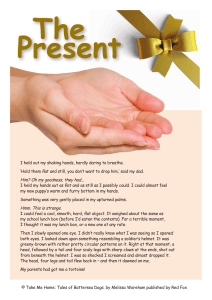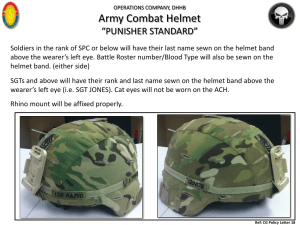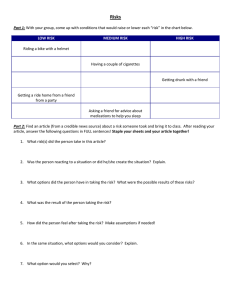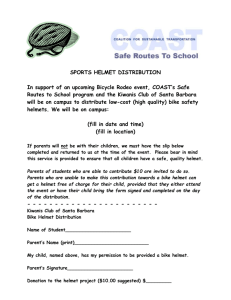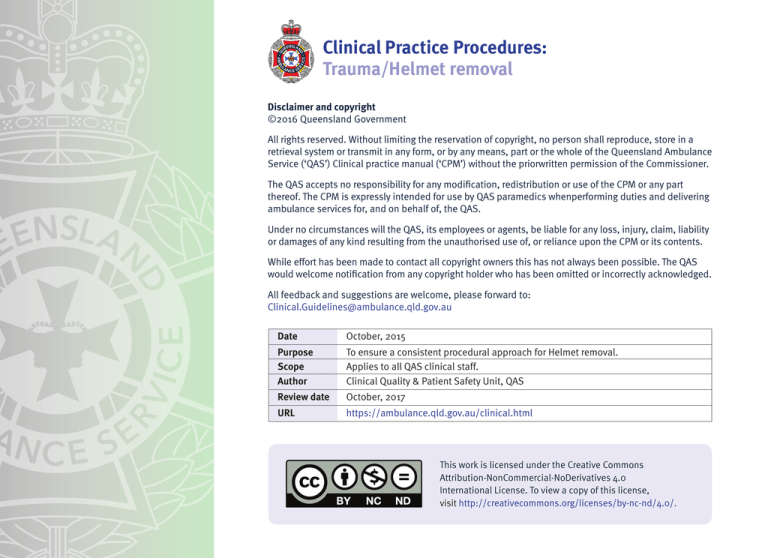
Clinical Practice Procedures:
Trauma/Helmet removal
Disclaimer and copyright
©2016 Queensland Government
All rights reserved. Without limiting the reservation of copyright, no person shall reproduce, store in a
retrieval system or transmit in any form, or by any means, part or the whole of the Queensland Ambulance
Service (‘QAS’) Clinical practice manual (‘CPM’) without the priorwritten permission of the Commissioner.
The QAS accepts no responsibility for any modification, redistribution or use of the CPM or any part
thereof. The CPM is expressly intended for use by QAS paramedics whenperforming duties and delivering
ambulance services for, and on behalf of, the QAS.
Under no circumstances will the QAS, its employees or agents, be liable for any loss, injury, claim, liability
or damages of any kind resulting from the unauthorised use of, or reliance upon the CPM or its contents.
While effort has been made to contact all copyright owners this has not always been possible. The QAS
would welcome notification from any copyright holder who has been omitted or incorrectly acknowledged.
All feedback and suggestions are welcome, please forward to:
Clinical.Guidelines@ambulance.qld.gov.au
Date
October, 2015
Purpose
Scope
Author
To ensure a consistent procedural approach for Helmet removal.
Applies to all QAS clinical staff.
Clinical Quality & Patient Safety Unit, QAS
Review date
October, 2017
URL
https://ambulance.qld.gov.au/clinical.html
This work is licensed under the Creative Commons
Attribution-NonCommercial-NoDerivatives 4.0
International License. To view a copy of this license,
visit http://creativecommons.org/licenses/by-nc-nd/4.0/.
Helmet removal
October, 2015
Helmet removal is required in all cases where a patient has a helmet still in situ.
This is necessary to allow adequate exposure to provide thorough patient
assessment and appropriate treatment.
Indications
UNCONTROLLED WHEN PRINTED
• Removal of a motorcycle helmet in the setting of trauma
There are many types of helmet in use with varying levels of safety technology
available. Paramedics should be aware of these differences as this may determine
the safest removal technique. An assessment of the helmet should occur before
any attempt at removal.
Contraindications
• Nil in this setting
Helmet
types:[1]
UNCONTROLLED WHEN PRINTED
Complications
Full face helmet: covers the whole head with a fixed chin bar.
This design offers the highest level of protection.
• Possible exacerbation of C-spine injury
Off road or motocross helmet: is the same design as the full face helmet with an elongated chin and visor. Usually worn for sport with goggles.
UNCONTROLLED WHEN PRINTED
Modular or flip up helmet: covers the whole head with a
moveable chin bar. The chin bar can be worn in open or closed
positions. Chin protection provided only when fixed closed.
Open face or 3/4 helmet: covers the ears, cheeks and back
of head. The face is exposed and there is no chin protection
UNCONTROLLED WHEN PRINTED
Half helmet: Covers the top of the head only. Offers minimal protection
Irrespective of helmet type or incorporated safety mechanisms, this procedure
should optimally be performed by 2 officers.
Figure 3.90
QUEENSLAND AMBULANCE SERVICE
631
Procedure – Helmet Removal
This procedure should be followed with consideration for different helmet types and safety mechanisms installed.
• Assess helmet for type and determine any incorporated safety mechanisms. Look for warning stickers, protruding tabs or tubes and removal instruction on the side of the helmet. The conscious patient may be able to advise paramedics on removal procedure.
UNCONTROLLED WHEN PRINTED
• Determine and agree on any alterations to standard removal procedure with assistant.
Standard helmet removal procedure[2]
1. The primary officer provides Manual In-line Stabilisation (MILS) from the front of the patient by placing one hand on the mandible and the other applying supportive pressure on the occipital region.
UNCONTROLLED WHEN PRINTED
2. Ensure any chin strap or guard is released or cut.
UNCONTROLLED WHEN PRINTED
UNCONTROLLED WHEN PRINTED
3. The second officer gently flexes the
helmet apart laterally and lifts in a
steady rearward motion avoiding
movement of the neck.
4.
As the helmet is removed, the primary officer may be required to
readjust hand position to provide
adequate support below the occiput.
5.
Once the helmet is removed, the responsibility of MILS should be safely transferred to an officer at the head end of the patient.
QUEENSLAND AMBULANCE SERVICE
632
Safety technology
e
Additional information
• If the patient is prone, maintain MILS
and log roll into the lateral or supine
position before removal where possible.
There are safety mechanisms that may be incorporated into motorcycle helmets. Paramedics should be aware of these and be looking for them on initial inspection while the helmet is still in situ. If the patient is conscious, they may be able to advise if safety technology is incorporated. The most common safety mechanisms are described here. Be aware that others may exist:
UNCONTROLLED WHEN PRINTED
• If bystander assistance is required, the paramedic should take the primary
role and provide MILS.
• If the patient requires transport, ensure
the helmet goes with them in order for
hospital staff to assess damage.
Emergency Quick Release System (EQRS)[3]
This mechanism allows the removal of the cheek pads while the helmet is still in situ. The cheek pads hold the helmet in place so once they are removed, the helmet can
subsequently be removed with little effort and minimal neck movement. The cheek pads are removed by pulling bilaterally protruding red tabs. This will allow each cheek pad to be pulled out through the bottom of the helmet. The helmet requires manual
stabilisation during this process as it will become loose as the cheek pads become
displaced. There may be instructions for use on the helmet.
UNCONTROLLED WHEN PRINTED
Main principles regardless of helmet
type and safety technology
• Removal should occur with
consideration of a possible cervical spine injury.
UNCONTROLLED WHEN PRINTED
• Continual communication between the 2 officers removing the helmet is paramount.
• Removal should not require excessive force.
UNCONTROLLED WHEN PRINTED
QUEENSLAND AMBULANCE SERVICE
633
Safety technology (continued)
Eject Helmet Removal System (EHRS)[4]
EHRS may be pre installed into any motorcycle helmet. It is designed
to aid in the safer removal of a helmet after an incident by pushing
the helmet off the head after the upper spine has been immobilised.
It consists of a deflated airbag (pre installed in the top inside of the
helmet) attached to some air tubing with a connector on the end.
This connector should be visible while the helmet is in situ and
recognised as a protruding tube from the posterior or lateral aspect
of the helmet. Look for warning stickers. This system can only be
activated using a separately stored inflator bulb which may be found
with the patient belongings or companion. Attach the inflator bulb to
the connector and once MILS is being provided, slowly squeeze the
inflator bulb repeatedly to inflate the airbag. This will cause the helmet to lift off the patient’s head. Manual manipulation of the
helmet is NOT required, however manual guidance and support is
necessary. If this inflator bulb is not located, revert to standard
helmet removal procedure.
If this is in use at an incident site ensure trained personnel are
activating it. If in doubt, revert to standard helmet removal
procedure. Paramedics should be aware of the existence of this device. This mechanism provides a closer fitting helmet
particularly around the chin bar area and allows removal of the
helmet with minimal movement of the head of neck.
UNCONTROLLED WHEN PRINTED
Full Helmet Airbag Technology[6]
This mechanism is incorporated into some full face helmets. It provides a full head coverage interior airbag designed to be
inflated at all times when the helmet is in situ. When inflated it
provides a very close fitting helmet so it is imperative that it is
deflated before any attempted helmet removal. Facial, head and
neck injury may result if this airbag is not deflated before removal.
The airbag can be deflated using a deflation button found inside
the chin guard area of the helmet to the left of a larger inflation
button. Look for warning stickers.
UNCONTROLLED WHEN PRINTED
UNCONTROLLED WHEN PRINTED
Rear system access[5]
Emergency personnel on-site at a race track may carry an Eject EMT
Kit. This is designed to be inserted into a helmet that is still in situ
and does NOT have pre-installed EHRS. This involves inserting a
deflated airbag into the top inside of the helmet using a thin tool
which is inserted between the forehead of the patient and the
helmet. This is then inflated to remove the helmet. This should only
be used by personnel specifically trained in its use. This does NOT
form part of QAS training.
UNCONTROLLED WHEN PRINTED
QUEENSLAND AMBULANCE SERVICE
634

